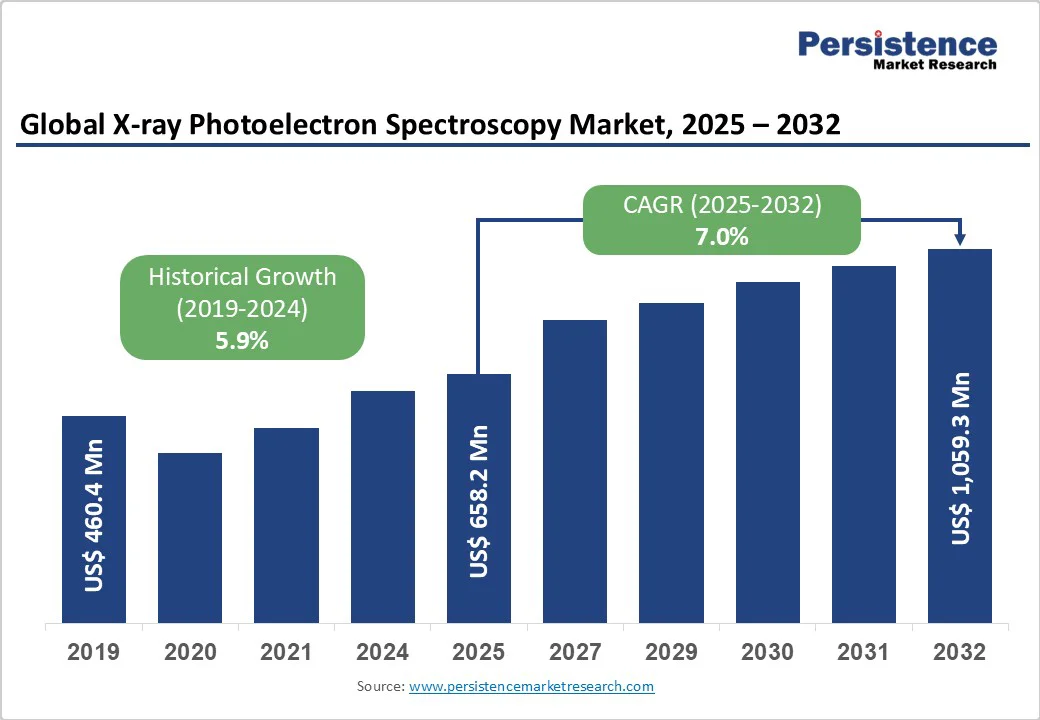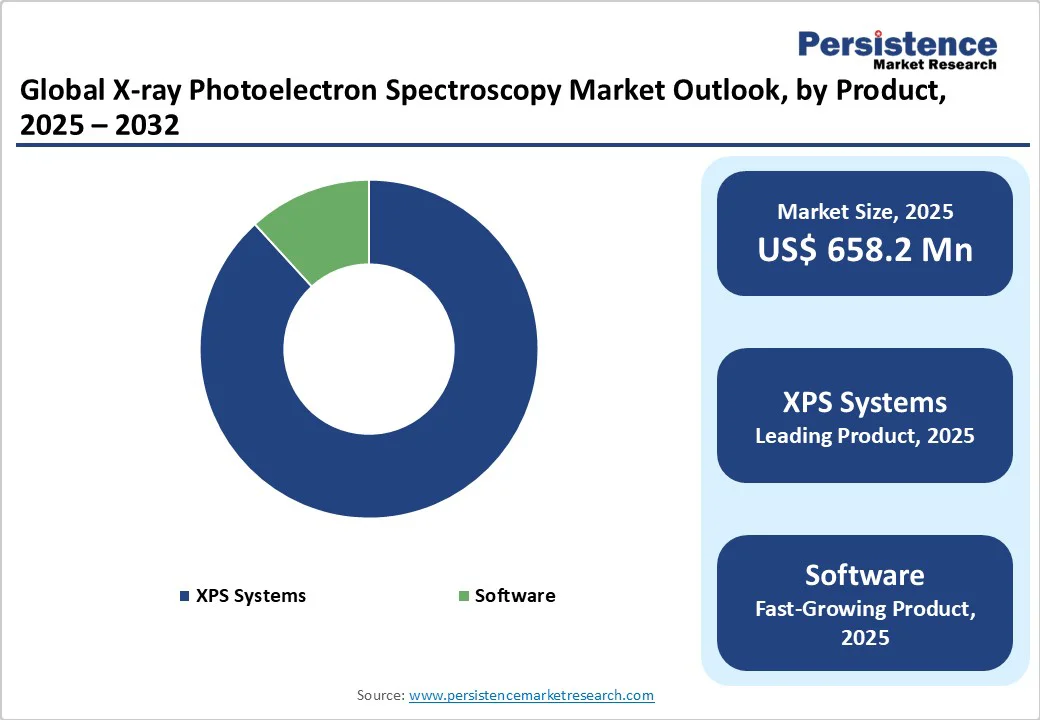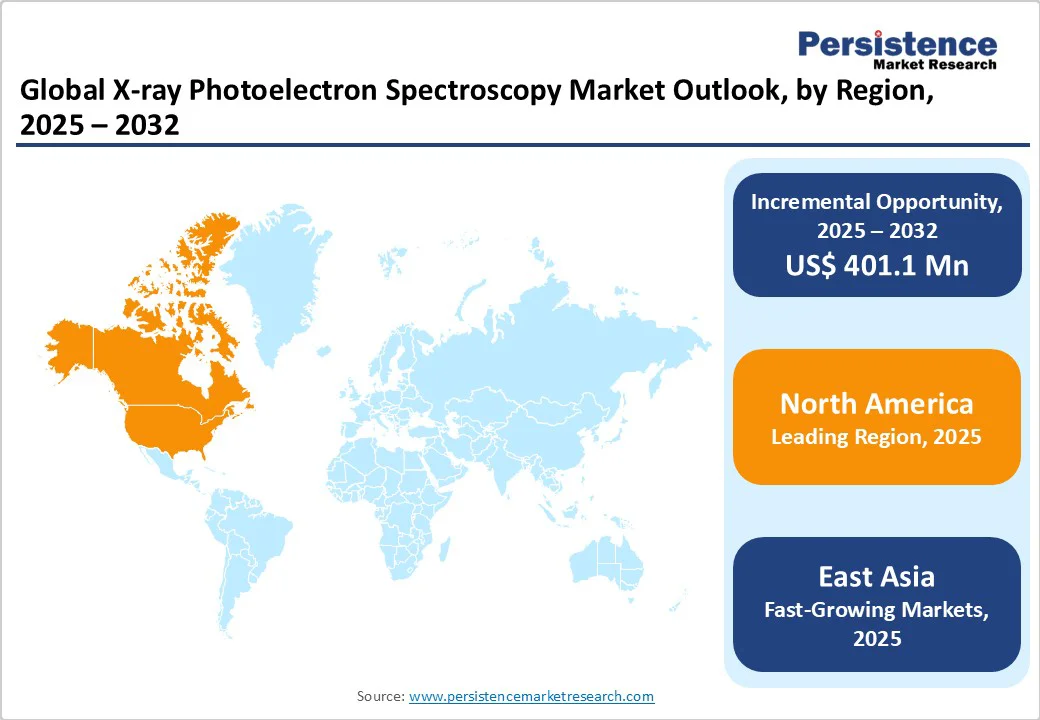ID: PMRREP18022| 199 Pages | 30 Sep 2025 | Format: PDF, Excel, PPT* | Healthcare

The global X-ray photoelectron spectroscopy market size is likely to value at US$ 658.2 Mn in 2025 and is projected to reach US$ 1,059.3 Mn by 2032, growing at a CAGR of 7.0% during the forecast period from 2025 to 2032.
The market growth is driven by increasing demand for advanced surface analysis and material characterization solutions. Rising research and development activities across electronics, pharmaceuticals, energy storage, and nanotechnology sectors are accelerating the adoption of XPS instruments.
| Key Insights | Details |
|---|---|
| Global X-ray Photoelectron Spectroscopy Market Size (2025E) | US$ 658.2 Mn |
| Market Value Forecast (2032F) | US$ 1,059.3 Mn |
| Projected Growth (CAGR 2025 to 2032) | 7.0% |
| Historical Market Growth (CAGR 2019 to 2024) | 5.9% |

XPS analysis is a reliable method when surface chemistry or thickness is critical for product functionality and safety. It provides a comprehensive breakdown of the elements present on a material’s surface, including their chemical state, elemental composition, electronic state, and empirical formula.
With detection limits around 0.1 atomic percent, XPS can identify all elements except hydrogen and helium, making it suitable for both conductive and insulating samples such as metals, semiconductors, glasses, ceramics, polymers, and adsorbed liquids or gases.
Industries using stainless steel prioritize rust prevention to ensure products and equipment are safe, durable, and function as intended. XPS evaluates friction, adhesion, corrosion, and chemical reaction properties to determine material reliability.
It can also detect contaminants or impurities on thin polymer or plastic layers, helping identify issues in the manufacturing process. For samples where metal interdiffusion is a concern, XPS provides empirical formulas with minimal surface contamination. Analysis can be completed in as little as 30 minutes in a trained materials lab. The growing adoption of XPS in various industrial processes is a key driver for market expansion.
XPS generates intricate spectra containing information about elemental composition, chemical bonding, and surface states, necessitating a thorough understanding of surface analysis techniques and spectroscopic principles for accurate interpretation.
Without specialized training, users may struggle to discern meaningful insights from the data, leading to misinterpretation or misrepresentation of results. Moreover, the interpretation of XPS spectra often involves sophisticated data processing techniques, such as peak fitting, background subtraction, and quantification algorithms, which require expertise to execute effectively.
Incorrect interpretation or incomplete understanding of these techniques can result in erroneous conclusions about sample composition or properties. Consequently, the requirement for trained personnel proficient in XPS data analysis acts as a barrier, particularly for laboratories or industries lacking access to skilled personnel or resources for training.
This challenge may involve efforts to enhance user-friendly software interfaces, develop standardized protocols for data analysis, and expand educational initiatives to promote proficiency in XPS techniques among a broader user base.
X-ray photoelectron spectroscopy (XPS) emerges as a powerful tool in the arsenal of quality assurance processes, offering precise analysis of surface contaminants and interface chemistry crucial for product integrity.
At the forefront of electronic device production, XPS serves as a critical method for scrutinizing surface cleanliness and identifying contaminants that could compromise performance or longevity. Whether it is residues from manufacturing processes, atmospheric pollutants, or organic compounds, even minute traces can lead to electrical shorts, corrosion, or device failure over time.
XPS enables thorough analysis, down to the atomic level, revealing the presence and chemical composition of these contaminants. Also, in electronic manufacturing environments, where precision and efficiency are paramount, XPS offers distinct advantages. The non-destructive nature of XPS allows for the analysis of delicate electronic components without altering their properties, minimizing waste and production costs.
Additionally, with advancements in instrumentation and automation, XPS systems can streamline quality control processes, providing rapid and reliable results to inform production decisions.
XPS systems have been pivotal in driving growth in the X-ray Photoelectron Spectroscopy market by providing precise, detailed surface chemical analysis for industrial and research applications. XPS systems take 88.2% of share in 2025.
Technological advancements have significantly enhanced their performance, offering high-resolution imaging, improved sensitivity, and faster data acquisition, making them indispensable across materials science, chemistry, physics, and engineering. In the semiconductor industry, XPS systems are critical for analyzing thin films and interfaces, supporting the development of smaller, more efficient electronic devices.
The rise of nanotechnology and biotechnology has further boosted demand, as both fields require nanoscale surface analysis. XPS helps investigate the composition and electronic states of nanomaterials and study biomaterials’ interactions with biological environments, facilitating innovations in medical devices and drug delivery systems.
Additionally, the growing focus on environmental sustainability and renewable energy drives XPS adoption in analyzing catalysts, solar cells, and battery materials. With industries and governments prioritizing sustainable solutions, the demand for XPS systems continues to expand, propelling market growth globally.
In the electronics and semiconductor industries, the development of advanced materials and miniaturized components has necessitated the use of XPS for analysing ultra-thin layers and interfaces. XPS helps in understanding the chemical composition and electronic structure of thin films, which is critical for improving device performance and longevity. The ability to detect contaminants and monitor the effects of different processing steps further underscores the importance of XPS in these sectors.
Solar energy is another area where thin film analysis via XPS plays a pivotal role. Thin film solar cells, such as those made from cadmium telluride (CdTe) and copper indium gallium selenide (CIGS), require precise compositional control to achieve high efficiency.
XPS offers essential insights into the elemental and chemical makeup of these films, facilitating the development of more efficient and cost-effective solar cells. In the coatings industry, XPS is used to analyse surface treatments and protective layers, ensuring their effectiveness in various applications, from corrosion resistance to enhancing aesthetic properties. The ability to study the surface chemistry of these coatings helps in developing new formulations and improving existing ones.

Market growth in North America is driven by several key factors that underscore the region's leadership in technological innovation and industrial advancement. North America's robust research infrastructure, supported by substantial government and private sector funding, has been pivotal.
Institutions such as the National Institutes of Health (NIH) and the National Science Foundation (NSF) provide significant grants for advanced materials research, which heavily utilizes XPS technology. This consistent investment in research and development fosters continuous advancements in XPS instrumentation and applications.
The presence of a highly developed industrial base, particularly in sectors like electronics, aerospace, and automotive, drives demand for precise surface analysis provided by XPS.
In the electronics industry, for example, the miniaturization of components necessitates detailed surface characterization to ensure product reliability and performance, a requirement that XPS is uniquely suited to meet. Similarly, in aerospace and automotive industries, material integrity and performance are critical, and XPS plays a crucial role in quality control and failure analysis.
Therefore, the well-established presence of leading XPS equipment manufacturers and suppliers in North America ensures ready availability and support for XPS systems. Companies such as Thermo Fisher Scientific, and PHI are headquartered in the region, providing cutting-edge technology and robust customer support, further facilitating market growth. Collectively, these factors create a dynamic and conducive environment for the sustained expansion of the XPS market in North America.
Europe is a major region in the X-ray Photoelectron Spectroscopy Market, holding a 28.6% share in 2025, Germany is the leading country in this region with 26.2 % share in Europe in 2025, driven by advancements in nanotechnology, materials science, and environmental research. Governments across Europe are investing in research infrastructures that support surface analysis techniques, including XPS, to enhance innovation in various sectors.
For instance, the European Commission's Horizon Europe program allocates significant funding to projects that utilize XPS for material characterization and environmental monitoring.
Initiatives such as the European Strategy Forum on Research Infrastructures (ESFRI) prioritize the development of cutting-edge facilities that incorporate XPS technologies to address challenges in energy, health, and climate change.
These strategic investments reflect Europe's commitment to maintaining a competitive edge in high-precision analytical techniques. The increasing demand for XPS systems is further supported by the growing need for detailed surface chemical analysis in various industries, including semiconductors, pharmaceuticals, and renewable energy. As a result, the European XPS market is poised for sustained growth, underpinned by robust government support and technological advancements.
The growth of the X-ray photoelectron spectroscopy market in East Asia has been driven by several key factors, making the region one of the most dynamic and rapidly expanding markets globally. One of the primary contributors is the robust industrial base in countries such as China, Japan, and South Korea. These nations have well-established electronics, semiconductor, and automotive industries that heavily rely on XPS technology for material characterization and quality control.
The increasing complexity and miniaturization of electronic components necessitate precise surface analysis, which XPS can provide, thus fueling its demand. Moreover, East Asia has witnessed substantial investments in research and development (R&D) activities, particularly in advanced materials and nanotechnology.
Government initiatives and funding programs aimed at fostering innovation and technological advancement have led to the proliferation of research institutions and universities equipped with state-of-the-art XPS systems. For instance, China's strategic initiatives like "Made in China 2025" emphasize the development of high-tech industries, further driving the adoption of sophisticated analytical tools like XPS.

Collaborations and partnerships to develop innovative products and accelerate their launch across nations are the key growth strategies followed by the key players in the market. Companies are continuously investing in research and development to introduce innovative and novel interference blockers.
The global X-ray photoelectron spectroscopy market is projected to value at US$ 658.2 Mn in 2025.
Increasing R&D activities, nanotechnology preferred, semiconductor demand, advanced materials analysis, environmental monitoring, and government-funded research drive the global market.
The global X-ray photoelectron spectroscopy market is poised to witness a CAGR of 7.0% between 2025 and 2032.
Expanding nanotechnology, semiconductor innovation, renewable energy research, pharmaceuticals, advanced materials characterization, environmental monitoring, and adoption in academic-industrial labs offer key XPS market opportunities.
Major players in the global are Thermo Fisher Scientific Inc., Shimadzu Corporation, JEOL Ltd., ULVAC-PHI, INCORPORATED, Nova Ltd. and others.
| Report Attribute | Details |
|---|---|
| Historical Data/Actuals | 2019 - 2024 |
| Forecast Period | 2025 - 2032 |
| Market Analysis | Value: US$ Mn |
| Geographical Coverage |
|
| Segmental Coverage |
|
| Competitive Analysis |
|
| Report Highlights |
|
By Product
By Application
By End-use
By Region
Delivery Timelines
For more information on this report and its delivery timelines please get in touch with our sales team.
About Author